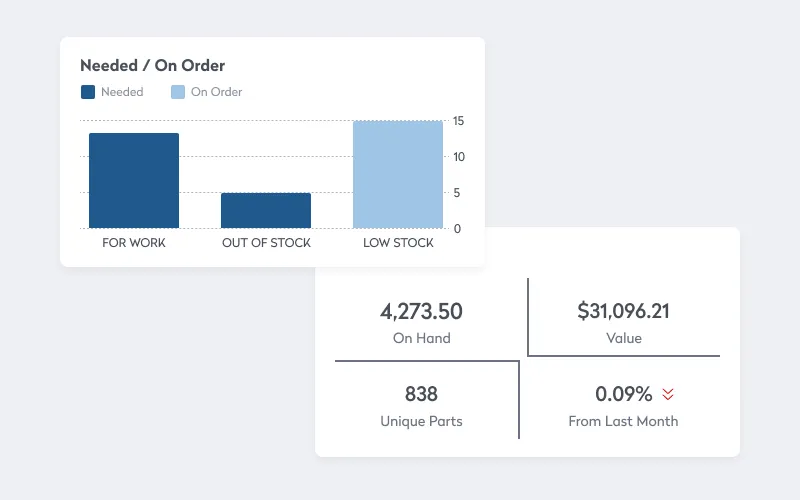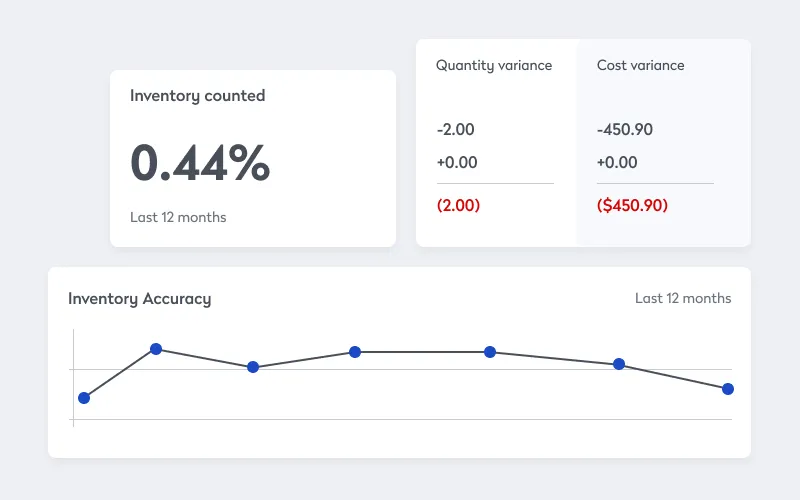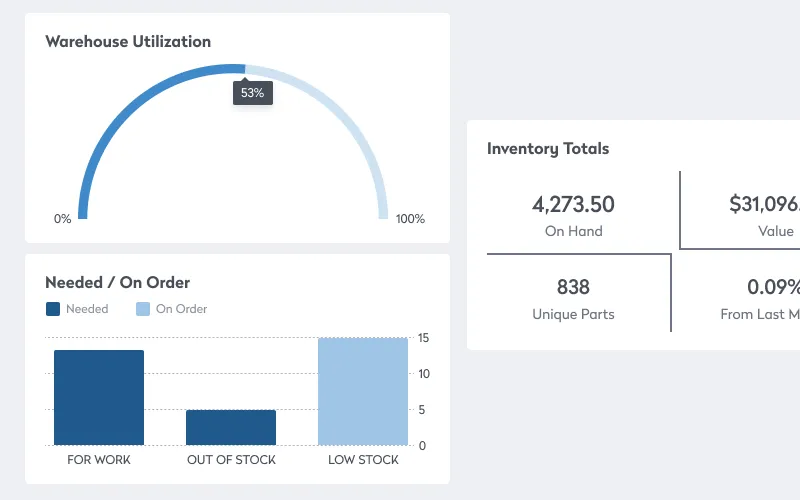
With reliable real-time inventory counts, companies can avoid the waste of overstocking and the delays of stockouts, minimizing waste and carrying costs, while reducing unplanned downtime. But it’s more than just keeping accurate counts. By understanding the various systems for inventory control and then implementing the right software platform, facility and maintenance managers gain a strategic advantage that boosts operational efficiency and lowers costs.
And the benefits are even greater at larger companies that have their inventory spread out across multiple locations. Cross-location inventory sharing means less need for duplication and often faster deliveries between facilities.
What is inventory management?
Although it can go by many names, including inventory management, inventory control, and stock management, it all comes down to implementing processes and procedures that ensure you have the right inventory at the right time for the right price.
Getting those three factors to line up — item, time, and cost — can be a balancing act, made more challenging because it involves a long unbroken chain of manufacturing, warehousing, shipping, and distributing that ends inside your supply closet.
Why is inventory management important for facility and maintenance managers?
Facility and maintenance managers pay for poor inventory management in many ways and at multiple times. If you try to play it safe by keeping a lot of maintenance parts and materials on hand, you often end up losing many of them.
Over time, inventory can:
- Degrade or rot
- Survive into obsolescence
- Fall victim to shrinkage
The rubber on the tires you bought as backups starts to fall apart, or the cans of lubricant lose their viscosity. You might end up with a spare part for a piece of equipment you retired the year before. Small replacement bulbs go missing. And not only do you lose the money you originally spent on the parts, but you’ve also wasted space, time, and money keeping them around. Even just throwing them out costs money, too. And those disposal costs are likely to rise, as landfills run out of space and new environmental laws come into effect.
There is also the cost of lost opportunities. Because you had your budget tied up in inventory, you didn’t have a chance to invest it in other places. You could have used that money to increase the annual boot allowance for the technicians, for example. Or purchased a better meter for inspections. In fact, basically any other use for that money would have been better than wasting it on buying things you only ever throw out.
But if you try to risk it by keeping the lowest possible amount of inventory on hand, you often end up spending even more. Not having the right parts or materials on hand doesn’t mean you won’t eventually need them. It just means that when you do need them, you’re facing extended downtime and expensive rush deliveries. When the line goes down at the height of a critical production run, the last thing you want to hear is that the part you need is sitting four states and two days away in your supplier’s warehouse.
But poor inventory control costs more than just money. You also pay in stress and frustration, and those are bad for productivity over time.
What are the common inventory management techniques?
The best way to manage your inventory is with careful tracking, and nothing tracks a lot of moving parts more reliably than inventory management software. Because it automates so many of the steps in the process, you reduce the risk of small clerical errors adding up to big, expensive problems. That said, the more you know about inventory control as a general topic, the better.
Economic order quantity (EOQ)
Dating back to 1913, the EOQ is a formula for determining the maximum amount of inventory you should purchase to minimize your costs, including what it costs to order and hold the inventory as well as any costs associated with being caught empty handed.
The system works well when both costs and rates of usage are steady. For maintenance departments stuck surviving on on-demand work orders, this is tricky. But once they make the jump to preventive maintenance, where the department schedules most work well in advance, everything can become a lot more predictable, including required inventory levels.
Minimum order quantity (MOQ)
A supplier’s MOQ is the smallest amount of stock they will sell. If you can’t buy that amount, it’s not worth their time to sell to you.

One way to think of it is the difference between wholesale and retail. A wholesaler can get you a great deal on hammers, but you must buy at least a shipping container’s worth of them. The hardware store can sell you one at a time, but you end up paying more.
Just-in-time inventory management
Here, the goal is to push all the carrying costs back onto the supplier without ever having to worry about running out of stock. The key is to have inventory arrive just before you use it in the production cycle. Japanese automakers were the first to develop and implement the system. Because they had a tightly controlled schedule for their production runs, they knew almost exactly when inventory should arrive.
For maintenance departments using preventive maintenance, all the parts and materials associated with an inspection or task (PM) arrive just before the technicians start. In theory, this solves the problem of carrying costs. In practice, it might be impractical to arrange a constant stream of small deliveries, each only a few parts each.
Safety stock inventory
Even the best plans need backup plans, and even the best-laid schedules can run into unexpected problems, so it’s common for managers to carry a bit of a buffer. Safety stock is that little bit extra you keep around for when you might need it. The justification for the extra money you spend here is the same as what you spend on insurance premiums. Hopefully, you never need to use the policy, and what you’re paying for is peace of mind.
Reorder points, par and min/max levels
Once you can predict your rate of use, you can start setting your reorder points, which is the minimum amount you should keep in inventory before ordering more. Par and min/max levels are basically the same thing.
For example, if you know you use one Part XYZ a month, and it takes a month to get them delivered, you would set your par level for two. As soon as you get down to two Part XYZs, you can order more, knowing you have enough in stock (plus an extra) to last you until the new ones arrive. A good facility management solution lets you set your par levels, so the software alerts you as soon as you hit your min level.
First in, first out (FIFO) and last in, first out (LIFO)
There’s a good reason some people reach all the way to the back of the cooler at the grocery store to grab what they assume is the freshest milk.
With first in, first out, you use the oldest inventory first. But with last in, first out, you use the newest.
Perpetual inventory management
When you do everything manually, it can make sense to do inventory counts infrequently. Trying to keep accurate, real-time numbers isn’t worth the extra work. Perpetual inventory management counts everything as it comes in, ensuring better accuracy. Although it is possible to do it with pen and paper, good inventory management software makes the process so much easier, your numbers so much more reliable.
Drop-shipping
For maintenance managers, this isn’t something you’d likely do, but it is something you should know about. Drop-shipping is when your supplier acts as a sort of middleman between you and whoever is supplying the inventory.
You place an order with Company A, they place an order with Company B, arranging to have the shipment sent directly to you. This arrangement is different than a traditional wholesaler, who more likely would be in physical possession of the inventory at some point in the supply chain.
There can be advantages to this system, with drop-shippers offering lower prices. But you likely lose assurances of quality control and are forced to trust a third party you have not personally vetted.
Once you decide to take control of your inventory, there are three main steps.
Do a physical inventory count
Before you know what to do with what you have, you need to know what you have. And remember, you can’t really trust your existing records. If you could trust them, it would mean you already had a great system in place.
So, you’re going to need to physically count your existing inventory. The information you collect is going to help you with the other steps.
In the past days, physical counts would start with handing out clip boards and hoping everyone managed to write everything in the right columns. Inventory management software, and the inventory module built into a unified asset management platform, makes the process a lot more reliable, especially for enterprise-level organizations spread across multiple locations, facilities, and buildings.

Imagine you’re carrying spare fan belts at two locations in your multi-facility organization. Some are at Plant A, some at Plant B. With a paper-based count, you’ll need someone to notice you’ve got the same parts in two places and add their numbers up. But with modern cloud-based software solutions, all the information you collect is stored in the same database, seamlessly updated in real-time. Your counts are accurate, even with inventory spread across facilities.
Get more than just the count
While you’re counting, make sure to get as much information about your inventory as you can. Numbers and amounts are just the beginning. Where it’s possible and appropriate, try to gather things like serial and lot numbers, country of origin, supplier, and cost. Down the road, this information can be invaluable.
For example, knowing the supplier makes reordering a lot easier. Knowing the lot number can mean avoiding a lot of grief. Once two items from the same lot fail much sooner than they should have, it’s easy to track down the remaining ones you need to return to the supplier for a refund or replacements. And keeping tabs on the cost of an item lets you know when it’s time to negotiate a bulk buy or switch suppliers completely.
Here, again, inventory management software is going to make your life a lot easier. Instead of going through piles of paper, everything you need inside one system.
Prioritize your inventory
There’s more than one way to do this, and each has it’s benefits and drawbacks. One of the classic methods is A, B, and C. Another involves looking at criticality. The first allows you to set levels of control, how tightly you guard and how closely you track the inventory. The second can help you set min and max levels.
A, B, and C
Divide your inventory into three groups, and then establish different levels of control for each one. Inventory in A takes up the smallest portion of your overall inventory, but it’s also the most expensive and critical to your success. You’ll set up tight controls and collect and track as many data points about that inventory as possible. Inventory in C is basically the opposite. It’s the largest portion, but also often the least expensive and least valuable to overall operations. The items and materials in B are everything that falls between A and C.
The reason B exists at all as a category is to prevent things from A or C sliding in and out of the categories as prices and situations fluctuate.
For example, you’re running a fulfillment center, which means you have a lot of conveyor belts. The motors that run them are in category A because you have relatively few of them, they’re expensive, and they’re important. You’ll have tight controls over them, including keeping them under lock and key and having a formal, restricted process for purchasing and taking delivery. Over in category C, you have disposable earplugs. They come in boxes of 200 pairs, and you only ever track boxes, which means your count is off at any given time by between zero and 199 pairs. Category B might have some of the smaller replacement belts.
Assert criticality
There’s a whole art and science to determining criticality, but we can sum it up as the answer to this question: How bad is bad? If an asset fails, how bad it is going to be for the organization. And remember, there are both different degrees and types of bad.
A failure might cost you a little bit or a lot of money. That’s a difference of degree. But instead of money, a failure might lead to a safety hazard. Between money and safety, that’s a difference of type. So, for each asset, you determine the criticality. Then you look at the parts and materials you need to keep your critical assets up and running. When setting min and max levels, make sure to give yourself enough of a safety buffer as insurance.
Criticality isn’t the only way to set min and max levels. With a good facility management system, you can use associated parts and materials connected to completed work orders for usage trends over time. If you know you use a part once a week and the lead time is five weeks, you’ll need to keep about five or six in inventory.
Decide on roles and who can do what
Once you have an accurate count and a good idea of what and when to order moving forward, you’re going to want to protect your hard work. You need to set up processes for who can place orders and who can accept deliveries. Although it’s possible to let all your technicians order parts and materials as they need them, it’s likely a better idea to restrict ordering permissions. In fact, you can have the software do most of the work for you. By setting customizable min and max points, the software can send you an alert or place the order for you once you dip below a set point.

It’s also important to set up specific processes for accepting deliveries. In the case of something like earplugs, it’s likely best to just count the boxes and assume they have the right number of individual pairs. For something like an electric motor, you’d want to make sure it works before adding it to your inventory. You’ll also need a system in place for accepting partial deliveries. You might have ordered 100 cogs, but because of logistical issues with the supplier, you’re going to get 45 on Monday and the rest on Thursday. The good news is that good inventory tracking software, or the purchase order module in inventory management software makes tracking partial deliveries easy.
How do you measure to see if you are successfully managing inventory?
One simple way is to look closely at how much money you’re spending on inventory, including what you’re paying for parts and materials, shipping, carrying costs, and how much you’re throwing out unused or losing to shrinkage.
But remember that when you’re successfully managing your inventory, you’re saving on more than just direct inventory costs. With good inventory management, you should also see a dip in unscheduled downtime. It’s not that the inventory directly prevents breakdowns, but when things go unexpectedly wrong, having the right parts on hand ensures you can get things up and running again faster.
In the end, inventory management is how you ensure you have the right part at the right time for the right price. It’s a balancing act, and the last thing you want to do is try to play it safe by overstocking only to waste money carrying inventory you never use. The other last thing you ever want to do, though, is get caught without that key part you need to keep critical assets up and running. With modern cloud-based inventory management, the process is automated and streamlined, making your inventory numbers more reliable and work less stressful.








